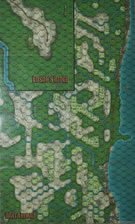|
The Galloping Horse Jungle Fighting #15 |
||
|---|---|---|
| (Defender) Japan | vs | United States (Attacker) |
| Formations Involved | ||
|---|---|---|
| Japan |  |
229th Infantry Regiment |
| Japan |  |
230th Infantry Regiment |
| United States |  |
27th Infantry Regiment |

|
| Overall Rating, 2 votes |
|---|
|
3.5
|
| Scenario Rank: --- of 964 |
| Parent Game | Jungle Fighting |
|---|---|
| Historicity | Historical |
| Date | 1943-01-10 |
| Start Time | 07:15 |
| Turn Count | 24 |
| Visibility | Day |
| Counters | 69 |
| Net Morale | 1 |
| Net Initiative | 0 |
| Maps | 1: Guad-ME |
| Layout Dimensions | 84 x 55 cm 33 x 22 in |
| Play Bounty | 143 |
| AAR Bounty | 161 |
| Total Plays | 2 |
| Total AARs | 2 |
| Battle Types |
|---|
| Hill Control |
| Rural Assault |
| Conditions |
|---|
| Entrenchments |
| Hidden Units |
| Off-board Artillery |
| Randomly-drawn Aircraft |
| Scenario Requirements & Playability | |
|---|---|
| Battle of the Bulge | Counters |
| Guadalcanal | Maps + Counters |
| Jungle Fighting | Base Game |
| Introduction |
|---|
|
Patch assigned the newly-arrived 25th Infantry Division two operations to open the drive west from Point Cruz. The 27th Infantry Regiment received the first assignment, securing the feature known as the Galloping Horse. A series of hills which together had the appearance of a horse, the position 3,000 yards inland was an important objective in the planned advance. |
| Conclusion |
|---|
|
The Time on Target artillery shoot cleared the approach to the 1st Battalion's objective and the Americans encountered no resistance until the soldiers reached Hill 57 (hex 0516). The 3rd Battalion approach was not so easy. The soldiers reached Hill 52 (hex 0517) before consolidating for the night. |
| Additional Notes |
|---|
|
Cassino '44 or Elsenborn Ridge may be used instead of Battle of the Bulge for the U.S. units. |
| JF #15 The Galloping Horse AKA The Thin Red Line's "Dancing Elephant" |
|---|
|
This is a really neat Scenario. Anyone reading James Jones's book the Thin Red Line will recognize this scenario from the book and the two movies. The Japanese set up on the hill in all the victory hexes entrenched and dug in. The American's sent one Battalion to the Horse's legs and one Battalion to the horse's head. Us artillery and air power had little effect on the Japanese and the U.S. suffered a number of demoralizations and disruptions and two step losses getting into assault position. But the U.S. still had enough to keep the pressure up. Despite never being able to bring their whole weight to bear they made slow but steady progress taking Japanese positions in victory hexes. The Japanese artillery was a going concern the entire scenario as they never failed their post bombardment ammo check until late in the game (scenario special rule). Once the U.S. artillery was used up the U.S. found the going harder. To make matters worse the original plan to unite both mortar platoons under a decent leader took forever to accomplish what with fog of war rolls and so many disrupted units that took priority. Going into the last turn the Japanese still had two hexes of the Horses head in control but the U.S. had lost less than 7 steps. The U.S. could have taken the game in the last turn had both their assaults won out but only one did leaving one hex disputed. Draw. If you like infantry battles this is a good one. |
| 0 Comments |
| Jungle Fighting #15 | ||||||||||||
|---|---|---|---|---|---|---|---|---|---|---|---|---|
This time the Americans get to try and take a different entrenchment line, this time on a bald hill. They get similar OBA restrictions but 1 extra barrage before the game. They also get morale 8 which makes everything much more possible. The Japanese are thin on the ground for the frontage they have to defend, so they attempt to make the most of their entrenchments, placing them forward at the suspected entry points filled up with their HMGs and 70s. On the wings they place two counterattacking stacks to try the same tactics that usually pay off. Close assault is still their most powerful weapon. Their VCs have a kill count to achieve, and they will be aggressive towards it. Playing passively will just give the USA more time. Americans start in two groups but converge on the northern most outcropping after pounding the hill with all their OBA on approach. The first turn they lose as step to a good OP fire roll but otherwise get their units in position, including 2 3XHMG stacks adjacent to the outcropped entrenchment. They continue to be patient until they get some decent rolls and break the Japanese back. Having very few men in the hills (reduced further by the counterattack strategy), each step loss is felt. Over time the first entrenchment falls, then the second. At this point they have little opposition and brute force the rest. The counterattacks didnt work for once. The Americans kept rolling 5s and 6s and the Japaense 3s. just shy of the step loss results. For the first time in a while the strategy fell flat on its face. The Americans clear the hill having taken only 3 step losses, for a win. This one seemed far better than the preceding Mt Austin scenarios, despite similar concepts. |
||||||||||||
| 0 Comments |

 JuFi014
JuFi014 


















